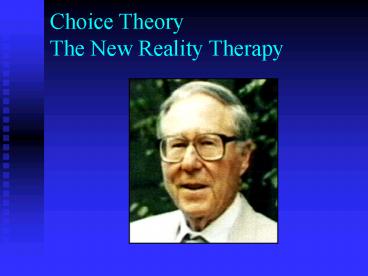Choice Theory The New Reality Therapy - PowerPoint PPT Presentation
1 / 13
Title:
Choice Theory The New Reality Therapy
Description:
Axioms Continued. We can only satisfy our needs by satisfying the pictures in ... but encourage people to judge all they are doing by the Choice Theory axiom: ... – PowerPoint PPT presentation
Number of Views:229
Avg rating:3.0/5.0
Title: Choice Theory The New Reality Therapy
1
Choice Theory The New Reality Therapy
2
The Central Idea
- All we do is behave, and
- almost all behavior is chosen
3
Five Basic Needs
- survival
- love and belonging
- power
- freedom
- fun
4
Central Need
- In practice, the most important need is love and
belonging as closeness and connectedness with the
people we care about is the requisite for
satisfying all of the needs. - Disconnectedness is the source of almost all
human problems - Disconnectedness comes from trying to control
OTHERS
5
External Control PsychologyThe ways we try to
control others
- Seven Deadly Habits
- CriticizingBlamingComplainingNaggingThreaten
ingPunishingBribing or rewarding to control
6
Key Axioms of Choice Theory
- The only person whose behavior we can control is
our own. - All we can give another person is information.
- All long-lasting psychological problems are
relationship problems. - The problem relationship is always part of our
present life. - What happened in the past has everything to do
with what we are today, but we can only satisfy
our basic needs right now and plan to continue
satisfying them in the future.
7
Axioms Continued
- We can only satisfy our needs by satisfying the
pictures in our Quality World. - All we do is behave.
- All behavior is Total Behavior and is made up of
four components acting, thinking, feeling and
physiology. - All Total Behavior is chosen, but we only have
direct control over the acting and thinking
components. We can only control our feeling and
physiology indirectly through how we choose to
act and think. - All Total Behavior is designated by verbs and
named by the part that is the most recognizable.
8
Seven Caring Habits
- SupportingEncouragingListeningAcceptingTrust
ingRespectingNegotiating differences
9
Reality Therapy
- Focus on the present and avoids discussing the
past because all human problems are caused by
unsatisfying present relationships. - Avoids discussing symptoms and complaints as much
as possible since these are the ways that
counselees choose to deal with unsatisfying
relationships. - Understand the concept of total behavior, which
means focus on what counselees can do directly
act and think.
10
- Avoid criticizing, blaming and/or complaining and
help counselees to do the same. By doing this,
they learn to avoid these extremely harmful
external control behaviors that destroy
relationships. - Remain non-judgmental and non-coercive, but
encourage people to judge all they are doing by
the Choice Theory axiom - Is what I am doing getting me closer to the
people I need?
11
- If the choice of behaviors is not getting people
closer, then the counselor works to help them
find new behaviors that lead to a better
connection. - Teach counselees that legitimate or not, excuses
stand directly in the way of their making needed
connections. - Focus on specifics. Find out as soon as possible
who counselees are disconnected from and work to
help them choose reconnecting behaviors.
12
- If they are completely disconnected, focus on
helping them find a new connection. Help them
make specific, workable plans to reconnect with
the people they need, and then follow through on
what was planned by helping them evaluate their
progress. - Based on their experience, counselors may suggest
plans, but should not give the message that there
is only one plan.
13
- A plan is always open to revision or rejection by
the counselee. - Be patient and supportive but keep focusing on
the source of the problem disconnectedness. - Counselees who have been disconnected for a long
time will find it difficult to reconnect. They
are often so involved in the symptom they are
choosing that they have lost sight of the fact
that they need to reconnect.

